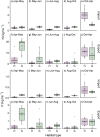Grazing by wild red deer can mitigate nutrient enrichment in protected semi-natural open habitats
- PMID: 35545720
- PMCID: PMC9225971
- DOI: 10.1007/s00442-022-05182-z
Grazing by wild red deer can mitigate nutrient enrichment in protected semi-natural open habitats
Abstract
Eutrophication through atmospheric nutrient deposition is threatening the biodiversity of semi-natural habitats characterized by low nutrient availability. Accordingly, local management measures aiming at open habitat conservation need to maintain habitat-specific nutrient conditions despite atmospheric inputs. Grazing by wild herbivores, such as red deer (Cervus elaphus), has been proposed as an alternative to mechanical or livestock-based measures for preserving open habitats. The role of red deer for nutrient dynamics in protected open habitat types, however, is yet unclear. Therefore, we collected data on vegetation productivity, forage removal, quantity of red deer dung and nutrient concentrations in vegetation and dung from permanent plots in heathlands and grasslands (eight plots à 225 m2 per habitat type) on a military training area inhabited by a large population of free-ranging red deer over one year. The annual nutrient export of nitrogen (N) and phosphorus (P) by red deer grazing was higher than the nutrient import through red deer excreta, resulting in an average net nutrient removal of 14 and 30 kg N ha-1 a-1 and 1.1 and 3.3 kg P ha-1 a-1 in heathlands and grasslands, respectively. Even when considering approximate local atmospheric deposition values, net nutrient depletion due to red deer grazing seemed very likely, notably in grasslands. Demonstrating that grazing by wild red deer can mitigate the effects of atmospheric nutrient deposition in semi-natural open habitats similarly to extensive livestock grazing, our results support the idea that red deer are suitable grazing animals for open habitat conservation.
Keywords: Atmospheric deposition; Cervus elaphus; Natura 2000; Nitrogen; Phosphorus.
© 2022. The Author(s).
Conflict of interest statement
The authors declare that they have no conflict of interest.
Figures


References
-
- Aarons S. Dung decomposition in temperate dairy pastures. I. Changes in soil chemical properties. Aust J Soil Res. 2004;42:107–114. doi: 10.1071/SR03008. - DOI
-
- Abbas F, Merlet J, Morellet N, Verheyden H, Hewison AJM, Cargnelutti B, et al. Roe deer may markedly alter forest nitrogen and phosphorus budgets across Europe. Oikos. 2012;121:1271–1278. doi: 10.1111/j.1600-0706.2011.20103.x. - DOI
-
- Alves J, Alves da Silva A, Soares AMVM, Fonseca C. Pellet group count methods to estimate red deer densities: precision, potential accuracy and efficiency. Mamm Biol. 2013;78:134–141. doi: 10.1016/j.mambio.2012.08.003. - DOI
-
- Augustine DJ, Milchunas DG, Derner JD. Spatial redistribution of nitrogen by cattle in semiarid rangeland. Rangel Ecol Manage. 2013;66:56–62. doi: 10.2111/REM-D-11-00228.1. - DOI
MeSH terms
Grants and funding
LinkOut - more resources
Full Text Sources
Research Materials

